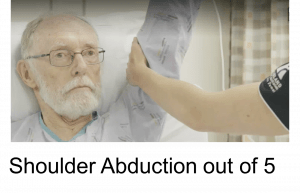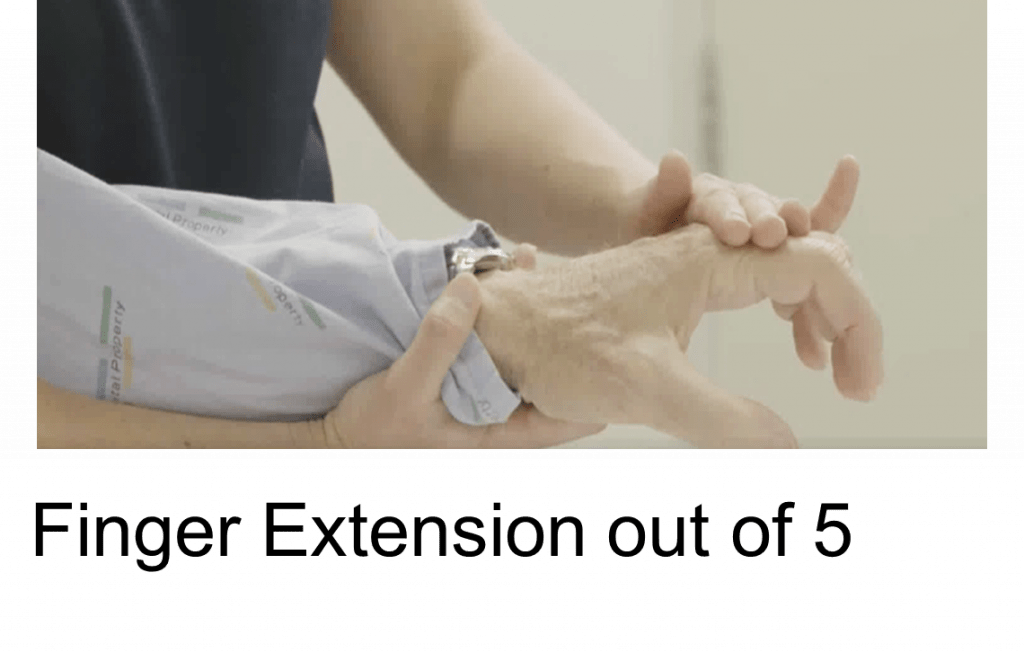Purpose
This training is intended to teach you how to perform the SAFE score with VERIFY participants. Each person performing the SAFE score with VERIFY participants will need to complete the practice and final quizzes at the bottom of this page.
Each person performing the SAFE score for VERIFY requires recertification annually to ensure consistency of performance. SAFE score recertification is done by completing the same practice and final quizzes at the bottom of this page, and uploading the resulting certificate onto WebDCU in the same way, that you did for your initial SAFE score certificate. Please email verify.study.tms@gmail.com if you have any questions.
SAFE Score
The SAFE score is calculated by scoring Shoulder Abduction (SA) and Finger Extension (FE) of the paretic upper limb using the Medical Research Council grades.
The patient’s strength in each of these movements is scored between 0 and 5, and then the two scores are added to calculate the SAFE score out of 10. You can use the grades below. Avoid using + and – signs to keep things simple.
It is critical to know how to perform the SAFE score for VERIFY. The SAFE score should be obtained at Visit 1, between Hours 48 and 96. One of the inclusion criteria for VERIFY is a SAFE score from 0-8.
Please be aware that a patient can score 0 on the arm component of the NIHSS and still have a SAFE score 0-8 and be eligible for VERIFY.
5 = normal power, with active movement through available range of motion against maximal resistance
4 = active movement through available range of motion against gravity and some (but not maximal) resistance
3 = active movement through available range of motion against gravity, but only with no resistance
2 = active movement through limited range of motion, but only with gravity eliminated
1 = palpable or visible trace muscle activity, but no joint movement
0 = no palpable muscle activity
SA and FE are graded separately out of 5, and then the two scores are added to calculate the SAFE score out of 10.
For patients with inattention or fatigue, make sure the patient is focused on the arm to give the most accurate indication of strength. Pre-existing musculoskeletal or other conditions can limit the patient’s available range of motion. In this situation, first evaluate the patient’s pain-free passive range of motion. Then evaluate their power through this available range of motion.
 Shoulder abduction should be tested through the patient’s full available range of motion.
Shoulder abduction should be tested through the patient’s full available range of motion.
If shoulder range of motion is limited by a pre-existing musculoskeletal condition, evaluate power within the patient’s pain-free passive range of motion.
Apply resistance proximal to the elbow joint for scores of 3 or more.
 Finger extension should be tested with the forearm pronated and the wrist stabilized, and through the patient’s full available range of motion.
Finger extension should be tested with the forearm pronated and the wrist stabilized, and through the patient’s full available range of motion.
Apply resistance distal to metacarpal phalangeal joints for scores of 3 or more.
If the fingers have unequal strength, use a majority rule:
-
- If three fingers have the same score, use this score.
- If two fingers have a lower score than the other two fingers, use the lower score.
The SAFE score can be made up of any combination of scores for shoulder abduction and finger extension.
A SAFE score of 5 (SA = 5, FE = 0) would indicate the participant has normal proximal shoulder movement but severe weakness in the fingers. Alternatively, a SAFE score of 5 (SA = 3, FE = 2) would indicate moderate weakness both proximally and distally. Participants with a SAFE score of 5 with either of these combinations of SA and FE scores would be eligible for VERIFY.
A SAFE score of 7 could be made up of any of the following, and a participant with any of the following would be eligible for VERIFY
-
- SA = 5, FE = 2
- SA = 4, FE = 3
- SA = 3, FE = 4
- SA = 2, FE = 5
The video below is a demonstration for how to evaluate and score both shoulder abduction and finger extension to obtain a SAFE score. Please ensure that you watch it before completing the quizzes.
Between 57s and 2m18s in the video below is another demonstration and description for obtaining the SAFE score, but you may need JOVE journal access from your institution to view it.
Determining the Functional Status of the Corticospinal Tract Within One Week of Stroke
Frequently asked questions
When should the SAFE score be obtained?
The SAFE score should be obtained at Visit 1, between Hours 48 and 96.
Visit 1 involves
- Obtaining informed consent
- Obtaining the SAFE score – if the SAFE score is 9/10 or 10/10 the patient is too mildly affected and is considered a screen fail
- Recording the patient’s demographic information as per the source document
- Completing a pregnancy test for the patient if applicable
What grade do I give if a patient has some movement against gravity but can’t achieve a full range of motion due to weakness from the stroke?
Score the affected movement as 2/5. For a score of 3/5 the patient needs to be able to achieve their full available range of motion against gravity.
How should I record a SAFE score when a patient has pre-existing pain, orthopedic or musculoskeletal issues?
If the patient has a pre-existing biomechanical restriction or pain, you will need to perform a more thorough assessment to determine any influences from pain, passive joint restrictions or previous strength deficit that influences the current SAFE score. Discussing with a colleague or obtaining a second opinion is useful any time a SAFE score isn’t clear.
For example, consider a patient who has bilateral osteoarthritis of the shoulders. In their words, prior to their stroke they were able to move both arms to about half-way and then it was too stiff and sore to go further. When scoring shoulder abduction evaluate their pain-free passive range of shoulder abduction motion first and assess their MRC relative to this. For example, if they had a passive range of motion of 90 degrees but active range of motion of 45 degrees with gravity eliminated, they would score 2/5. Whereas if they had active movement through their full available range of motion (90 degrees) against gravity but not resistance they would score 3/5.
Quiz
Click here for a quiz to assess your learning on the SAFE score.
Once the practice quiz has been completed with at least 70% correct you will be emailed a link to the final quiz for this module.
If you pass the final quiz with at least 80% correct you will be emailed a certificate of completion for the SAFE Score module. There is no limit to the number of attempts for the practice or final quiz.
Please contact us on verify.study.tms@gmail.com if you have any questions about the SAFE score.
